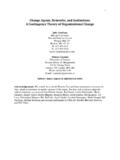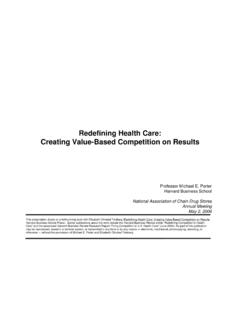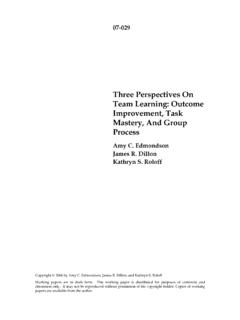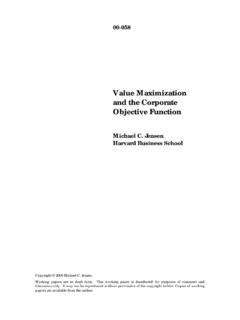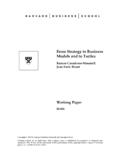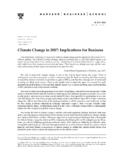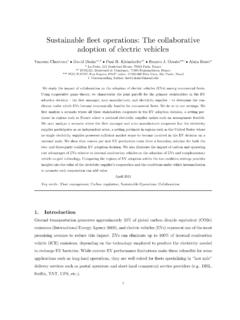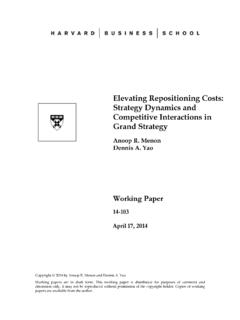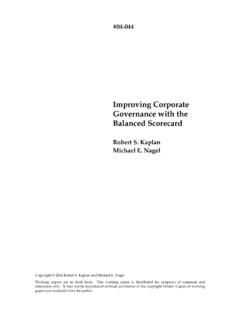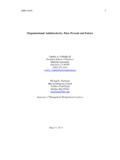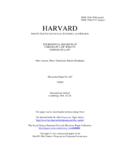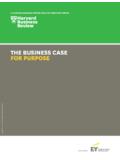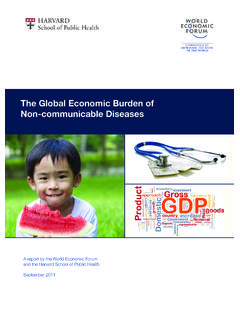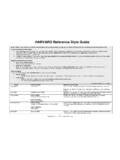Transcription of Creating an R&D Strategy - Harvard Business School
1 Creating an R&D Strategy Gary P. Pisano Working Paper 12-095. April 24, 2012. Copyright 2012 by Gary P. Pisano Working papers are in draft form. This working paper is distributed for purposes of comment and discussion only. It may not be reproduced without permission of the copyright holder. Copies of working papers are available from the author. Creating an R&D Strategy Gary P. Pisano Harry E. Figgie Professor of Business Administration Harvard Business School January 2012. Perhaps no single issue today is higher on the agenda of senior management than improving innovation performance. Whether you operate in a technology intensive Business like pharmaceuticals or electronics, or a more traditional manufacturing sector like automobiles, company growth in a highly competitive world hinges on superior R&D performance. And yet, no other endeavor frustrates management more than attempts to improve R&D performance.
2 Many R&D organizations have endured repeated restructuring, oscillations between centralized to decentralized models, endless process re-engineering, a barrage of team concepts, and a host of other management interventions with little to show for it. It is no wonder that new attempts to revolutionize the R&D process are often meet with jaded skepticism. The failure of many organizations to improve R&D performance is not due to lack of effort or commitment by the management or people involved. It is due to a misconception about the drivers of R&D performance. Too often, R&D performance is boiled down to a few simple universal practices. Unfortunately, there is no one best model for R&D that is universally superior. There is no magic bullet. R&D performance results from the interaction of many different decisions and choices, including the size and location of R&D facilities, the division of labor between various groups, the choice of technologies used inside the R&D organization, the selection of personnel, the allocation of resources, the design of processes for managing projects, and other factors.
3 An R&D organization is like any other system: performance hinges on the coherence between the components. And, like any other system, R&D organizations cannot be designed to do all things equally well. They face trade-offs. Every approach to R&D has strengths and weaknesses. It is because of the need for coherence and the need to manage trade-offs that R&D Strategy is an essential ingredient for achieving superior R&D performance. The Concept of Strategy A Strategy is nothing more than a commitment to a pattern of behavior intended to help win a competition. Hit to Joe's backhand is a Strategy you might deploy for your Saturday morning tennis game against your friend. It does not mean you will hit every shot to Joe's backhand (presumably, his weaker stroke), but you will try to emphasize shots to that side. Company strategies have the same flavor. Apple's Strategy , for instance, is to develop easy-to-use, aesthetically-pleasing products that integrate seamlessly with a broader system of devices in the Gary Pisano 2012.
4 1. consumer's digital world. This Strategy provides a guiding orientation for a broad range of Apple's Business decisions such as the selection of new R&D projects, the design of products, the composition of project teams, the choice of suppliers, the focus of marketing campaigns, the lay- out of Apple's retail stores, and even hiring of people. The Strategy implies a pattern of behavior with respect to all of these decisions. There are three essential purposes (and requirements) of a good Strategy . A good Strategy provides consistency, coherence, and alignment. 1. Consistency: Advantage is not the result of a single decision, but rather the cumulative outcome of a series of decisions, actions, and behaviors over time. A. good Strategy provides a framework for making consistent decisions over time that build cumulatively toward a desired objective. 2. Coherence: In a complex organization, many decisions are made each day that can shape competitive capabilities (who gets hired and promoted, which projects get funded, which pieces of equipment are bought, which partners are engaged for collaboration, etc.)
5 They are often made in far-flung corners of the organization (and, today, in different parts of the globe). Strategy provides an integrating mechanism to ensure these tactical decisions are coherent. Without a Strategy , it is impossible to achieve coherence. Organizations sometimes try to compensate for poor Strategy by Creating committees and others communication mechanisms to ensure decisions are integrated. But such devices are a poor and inefficient substitute for good, clear Strategy . 3. Alignment: Organizations thrive when their strategies are aligned to the realities of the environment or the broader organizational context in which they operate. An R&D organization needs to have a Strategy that is aligned with the broader Business Strategy of the organization in which it operates. A Strategy should help drive alignment. All strategies whether for a game, a whole Business , or a function like R&D come down to certain core hypotheses about what it takes to win.
6 For instance, in our simple example at the outset, the Strategy hit to Joe's backhand is predicated on the assumption that Joe's backhand is his weaker stroke. Apple's Strategy of providing easy to use, aesthetically pleasing, integrated Gary Pisano 2012. 2. system is predicated on a core hypothesis that customers will be willing to pay a significantly higher price for products with these attributes. Underlying many R&D strategies are hypotheses or assumptions about technical or scientific approaches that are likely to be most fruitful. Apple has made a bet around the virtues of integrated hardware and software systems. Boeing is making a bet that new composite materials will offer superior flight performance in airframes. Different automobile companies are making different technical bets on different engine systems to achieve higher environmental performance (hybrids, fuel cells, all electric, diesel, etc.)
7 Some pharmaceutical companies are betting heavily that genomics will lead to personalized medicine. There is often no way to test these hypotheses in advance. Thus, at some level, all strategies are bets . Experience executing a Strategy provides data that may cause you to revise your core hypotheses. Elements of an R&D Strategy R&D strategies, like all strategies, must start with the devilishly simply question: how do we intend to win? The game plan for an R&D organization can be broken down into 4 strategic levers: architecture, processes, people, and portfolio. Together, decisions made in each of these categories constitute the R&D Strategy (see Figure 1). Gary Pisano 2012. 3. Figure 1: Elements of R&D Strategy Where Architecture Centralization vs. Decentralization Size and Focus of Units Outsourcing vs. Internal How Who Processes People Development processes How do we intend to win?
8 Draft Strategy . Decision making process Specialist vs. Generalist Governance Ideal characteristics Metrics Portfolio Characteristics of ideal projects Mix and balance Criteria for selection/termination What 1. Architecture refers to the set of decisions around how R&D is structured both organizationally and geographically. This category includes decisions such as centralization vs. decentralization of R&D; the size, location, and focus of R&D units ( focus by market? focus by technology?); whether R&D units report to Business units or are autonomous;. whether research is organizationally separated from development; and the degree to which R&D utilizes external resources and partnerships. There is no single best architecture for an R&D organization. For instance, a highly centralized R&D organization facilitates communication and integration across different functional groups; at the same time, centralization forfeits the benefits of having a geographically diversified footprint of R&D.
9 Facilities located close to different global technology hotspots. The better approach depends on the organization's core hypotheses about what it takes to win. If it is betting on integration, then the centralized model is better. If it thinks tapping geographically diverse knowledge bases is the key to winning, then the decentralized model is a better route. 2. Processes are the formal and informal ways that R&D is carried out. This category includes choices about project management systems, the governance of projects (including the nature Gary Pisano 2012. 4. of senior management reviews), the sequence and flow of critical project tasks, the timing of reviews, and the metrics and indicators used to track projects. Too often, certain kinds of development processes are pitched as best practice when, in fact, process design is very contingent on the overall R&D Strategy .
10 Consider the choice between a highly structured . R&D process (with tightly specified procedures, review points, etc.) and a more flexible . process. Which is better? Again, it depends on broader R&D goals and other choices. An R&D organization working on highly novel (and highly uncertain) technologies may need much more process flexibility so that it can have the latitude to explore and iterate. In contrast, where R&D must be tightly coordinated with other functions (like manufacturing), a more tightly specified process may be necessary to keep everyone on the same page.. 3. People are obviously an enormously important aspect of an R&D system. Despite the growing use of sophisticated instrumentation, computer simulation, and laboratory automation, R&D is still a labor intensive process. Thus, choices about human resources-- such as the mix of generalists vs.
